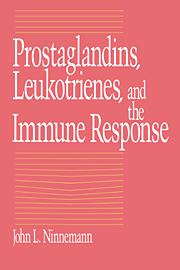Book contents
- Frontmatter
- Contents
- Foreword by James S. Goodwin
- Preface
- 1 A brief history and introduction
- 2 Prostaglandin/leukotriene structure and chemistry: a primer
- 3 Monocytes and macrophages
- 4 Lymphocyte response
- 5 Inflammation and the neutrophil
- 6 Malignancy and the arachidonic acid cascade
- 7 Tissue and organ transplantation
- 8 Rheumatoid arthritis and autoimmunity
- 9 Traumatic injury and surgery
- 10 Allergy
- Index
6 - Malignancy and the arachidonic acid cascade
Published online by Cambridge University Press: 24 November 2009
- Frontmatter
- Contents
- Foreword by James S. Goodwin
- Preface
- 1 A brief history and introduction
- 2 Prostaglandin/leukotriene structure and chemistry: a primer
- 3 Monocytes and macrophages
- 4 Lymphocyte response
- 5 Inflammation and the neutrophil
- 6 Malignancy and the arachidonic acid cascade
- 7 Tissue and organ transplantation
- 8 Rheumatoid arthritis and autoimmunity
- 9 Traumatic injury and surgery
- 10 Allergy
- Index
Summary
Arachidonic acid metabolites have been implicated as participants in every stage of the carcinogenic process, and as a probable cause for the lack of an effective antitumor immune response in many cancer patients. The realization that PGs might be involved in the suppression of a tumordirected immune response had its origin in the work of several groups concerned with the mechanism of cancer-associated hypercalcemia. As early as 1970, experiments by Klein and Raisz demonstrated that, along with parathyroid hormone, PGE2 was a particularly strong stimulator of bone resorption (1). Using a murine model, Tashjian et al. showed that the secretion of PGE2 by certain nonmetastatic cancers was associated with severe hypercalcemia (2). The association of PGE2 production and hypercalcemia has been reconfirmed in humans on many occasions (3). Largely because of this work, it became clear that many naturally occurring and experimentally induced malignant tumors synthesized large quantities of PGs. High concentrations of PGE and/or PGE metabolites have been found in the serum of patients with Hodgkin's and non- Hodgkin's lymphomas (Figure 6.1) (4), breast cancer (5), squamous cell carcinoma of the lung (6), renal cell carcinoma, and a large variety of other malignancies (6,7). In other studies, elevated blood levels of 6-keto- PGF1α, a degradation product of PGI2, have been found to occur in patients with various cancers, but its source has not been identified.
- Type
- Chapter
- Information
- Prostaglandins, Leukotrienes, and the Immune Response , pp. 113 - 135Publisher: Cambridge University PressPrint publication year: 1988
- 1
- Cited by



